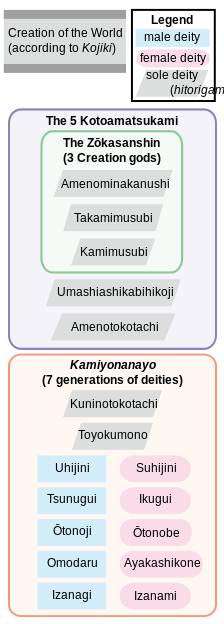Amatsukami

Amatsukami (Japanese: 天津神, 天つ神, 'Kami of heaven') is a category of kami in Japanese mythology. Generally speaking, it refers to kami born in, or residing in, Takamagahara.
Amatsukami is one of the three categories of kami, along with their earthly counterpart Kunitsukami (国津神, 国つ神), and yaoyorozu-no-kami (八百万の神).[1]: 56
Modern Shinto no longer makes the distinction between Amatsukami and Kunitsukami.[2] According to Yijiang Zhong the distinction was made by the writers of the Nihon Shoki and the Kojiki to formulate a political discourse.[3]
In the time of
Mythology
This section may contain material not related to the topic of the article. (October 2021) ) |
Amatsukami refers to kami residing in Takamagahara, along with kami who were born in Takamagahara but later descended to Japan.[5] In the mythological event of kuni-yuzuri, the descendants of amatsukami descended to pacify the world, which was occupied by the kunitsukami.[6][7] In Shinto practice, there is no clear distinction between amatsukami and kunitsukami, as their definitions change with time and in different source materials.[5][6][8]
Susanoo-no-Mikoto, who was cast out of Takamagahara, and his descendants, such as Ōkuninushi, are considered to be Kunitsugami.
List of amatsukami
- Kotoamatsukami
- Kamiyonanayo
- Shusaishin
- Others
- Ame-no-oshihomimi
- Ninigi
- Takemikazuchi
- Omoikane
- Ame-no-Koyane
- Ame-no-Uzume
- Ame-no-Tajikarao
- Tamanooya
- Futodama
- Ame-no-Wakahiko
- Ame-no-Hohi
See also
- Heavenly and Earthly crimes
- Aesir and Vanir
References
- ISBN 978-4770030443.
- ^ "kami | Definition, Translation, & Facts". Encyclopedia Britannica. Retrieved 2021-09-28.
- ISBN 978-1-4742-7109-7.
- ^ JSTOR 27822899.
- ^ a b Endō, Jun. "Amatsukami, Kunitsukami". 國學院デジタルミュージアム. Kokugakuin University. Archived from the original on 2021-01-16. Retrieved 2021-01-16.
- ^ ISBN 978-1-135-79739-3.
- ^ Kobori, Keiko. "Kuniyuzuri". Encyclopedia of Shinto. Kokugakuin University. Archived from the original on 2021-01-16. Retrieved 2021-01-16.
- ^ Institute for Japanese Culture and Classics (1985). Basic Terms of Shinto. Kokugakuin University. p. 26.


